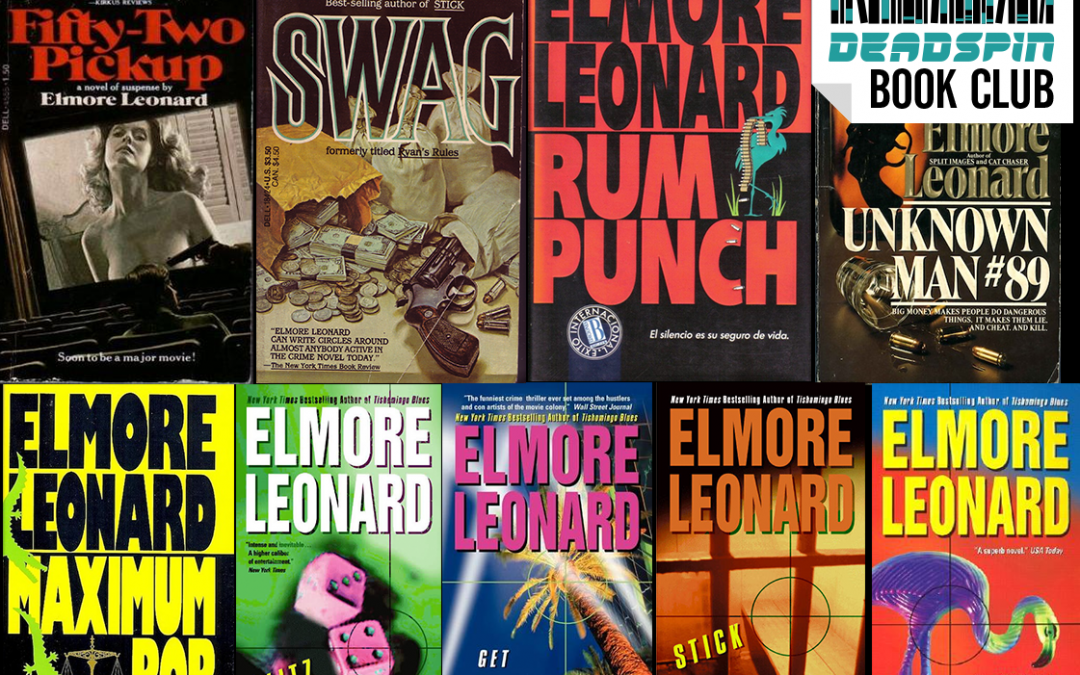One of the coolest things about Elmore Leonard’s crime fiction is that he didn’t get to it until he was close to 50 years old and had been a professional writer for more than 20. His books pared away anything unnecessary with the ruthless good cheer of a steely veteran with little patience for wasting time.
The 50-plus novels that followed (culminating in 2012’s Raylan, published a year before he died) read like movies because they’re informed by movies—they’re all mixed up in movies. “I liked Western movies a lot, and I wanted to sell to Hollywood right away and make some money,” Leonard once recalled of his early days selling short stories to Western magazines in the ’50s. Hollywood was definitely interested, but turning his work into a truly great film proved surprisingly tricky. “Elmore’s insights come from his narrator’s voice—that’s the real pleasure of his stories,” director William Friedkin once said. “And that’s hard to translate onscreen.”
But after many decent-to-horrible early adaptations, some filmmakers started getting it right, with Get Shorty, Jackie Brown, and Out of Sight coming in the ’90s alone, and his Raylan Givens series spawning the six-season FX hit Justified that wrapped up earlier this year. So you may know Leonard even if you’ve never read him.
If you’re new to Leonard, here’s a quick sampler of nine of his best. I’ve split the choices into three stretches of three straight books apiece, because I love the idea of streaks in an artist’s career—stretches when everything clicked. We start with the early Detroit novels in the ’70s, move to the tacky and creepy Miami underworld in the early-to-mid-’80s, and finish in the thick of Leonard’s prime.
The Early Years

Fifty-Two Pickup (1974)
In 1972, Leonard read and loved George V. Higgins’s celebrated crime novel The Friends of Eddie Coyle: He said the 1970 book helped him “loosen up” and “get into scenes quicker.” Just a couple of years later, he wrote Fifty-Two Pick Up.
In notes for a speech, Leonard wrote, “My crime stories are set in the present and usually within a relatively short time frame: a few days or weeks and with a certain urgency, something about to happen. I don’t care for novels that go on and on for years.”
Another thing you should know: Most of Leonard’s male leads are a variation of the same guy. The guy who isn’t the smartest and may not always come out on top. A good-looking fellow without being pretty, athletic (or at least not a klutz), pretty smart, honest, and direct. He’s not beyond mixing it up if he has to, but above all, he’s a guy who is cool. Rational, level-headed. Here, Harry Mitchell is a classic Leonard protagonist: a good guy, but one not to be fucked with. Also, the bad guys in this story get their share of space, and it’s clear how much Leonard enjoys them.
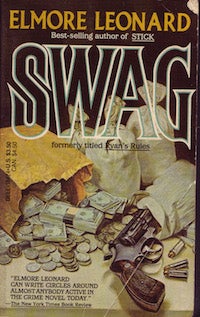
Swag (1976)
Originally titled The Frank and Ernest Method, this caper shows Leonard’s comedic chops. The book’s pleasures, aren’t in the plot, though, but the scenes, the characters, and especially all the dialogue. Your two heroes are Frank Ryan, a used-car salesman, and Ernest Stickley Jr., who steals cars. It’s Ryan—the more disagreeable (and quotable) of the two—who outlines his philosophy of crime on cocktail napkins:
ALWAYS BE POLITE ON THE JOB. SAY PLEASE AND THANK YOU. NEVER SAY MORE THAN IS NECESSARY. NEVER CALL YOUR PARTNER BY NAME—UNLESS YOU USE A MADE-UP NAME. DRESS WELL. NEVER LOOK SUSPICIOUS OR LIKE A BUM. NEVER USE YOUR OWN CAR. (DETAILS TO COME.) NEVER COUNT THE TAKE IN THE CAR. NEVER FLASH MONEY IN A BAR OR WITH WOMEN. NEVER GO BACK TO AN OLD BAR OR HANGOUT ONCE YOU HAVE MOVED UP. NEVER TELL ANYONE YOUR BUSINESS. NEVER TELL A JUNKIE EVEN YOUR NAME. NEVER ASSOCIATE WITH PEOPLE KNOWN TO BE IN CRIME.
I don’t think this is one of his best, but it’s a fun book and good company. Also, the last scene is expert, and boasts the most satisfying final line of any of Leonard novel.
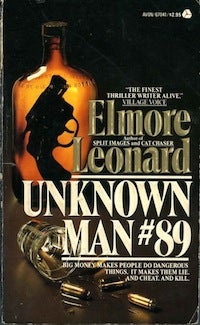
Unknown Man #89 (1977)
Five months before the publication of Unknown Man No. 89, Leonard took his last drink. In this novel, he takes an uncharacteristic detour from his usual taut plotting to address the protagonists’ troublesome relationship with alcohol. It feels like the scene in French Connection II when the movie yields for 15 minutes as Gene Hackman detoxes in a dank cell in Marseilles. But while the digression has autobiographical overtones, it’s not indulgent, and it’s marked by Leonard’s usual compression and rhythm:
Why he was drinking didn’t matter either. Because he was Irish or basically insecure? He was drinking. He could admit he was powerless over it once he got going, and he was still drinking. Sitting quietly in a bar, looking at his options and his reflection. He looked good, tan in the tinted bar mirror. His memory wasn’t too sharp, though. He wasn’t sure of the exact date, April 25 or 26. May 1 was a little too far off. The thing to do was call one of his friends in AA, admit he was fucking up and needed help, a kick in the ass. Or he could go to a meeting tonight. He hadn’t been to a meeting in about four months, and maybe that was his problem. Find one in the area. Call the main office and find out where to go in Pontiac. Go home and take a shower and a quick nap first, having something to eat. Pay and get out of here.
Or have just one more.
Miami Vices
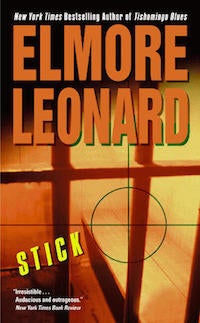
Stick (1983)
Here we’ve got Leonard entering his prime in terms of both quality and quantity (he wrote seven novels between Unknown Man #89 and this one), relocating from Detroit to southern Florida. It’s the ’80s, and time to revisit an old friend, he says, “to see what he’s up to now.” That’d be Earnest Stickley, last seen taking it on the chin in Swag.
Leonard never wrote a giant series with the same hero like other crime novelists (see Ross Macdonald’s Lew Archer or Lee Childs’ Jack Reacher), though he came close late in his career with the Justified-inspiring Raylan Givens. He did occasionally revisit characters, though, and Stick features one of my favorite Leonard protagonists. Also, there’s a real creepy bad guy in this one.
Burt Reynolds made Stick into an incredibly shitty movie, unfortunately, after which the author wrote the movie star a letter:
When I’m writing I see real people and hear real people talking. But when I view the picture I see too often actors acting, actors hitting the wrong word, mugging, overstating or elaborating on a punch line, ad-libbing clichés, setting a record for the frequent use of “asshole.” I hear what seem to me too many beats between exchanges, pauses for reactions, smiles for the benefit of the audience—like saying, “get it?”—or sneers or wide-eyed looks that I don’t see in real life.
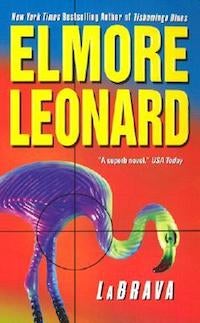
LaBrava (1983)
A classic South Florida novel full of Cubans, rednecks, Jews (both young and old), and an aging movie star. The atmosphere alone makes this a pleasure, and it’s considered to be one of Leonard’s finest. This time, the leading man is Joseph LaBrava, an ex-Secret Service man who’s now a professional photographer, whichgives Leonard the chance to weigh in on art-world pretension and no-nonsense craftsmanship. Here’s LaBrava talking to the aging movie queen, Jean Shaw:
“The review in the paper said, ‘The aesthetic subtext of his work is the systematic exposure of artistic pretension.’ I thought I was just taking pictures.”
Jean Shaw said, “Simplicity. It is what it is.” Then paused. “And what it isn’t too. Is that what you’re saying?”
He didn’t want her to try so hard.
….“You’re style is the absence of style. Would you say?”
He said, “No tricky angles,” because he didn’t know if he had a style or not. “I’m not good at tricky angles.”
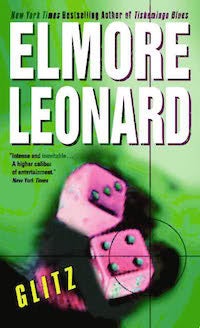
Glitz (1985)
Leonard’s first bestseller—every novel he published after was a bestseller, too. The bad guy, Teddy Magyk, is so twisted even his creator didn’t like him, and the novel has a genuine unpleasantness that is uncommon in Leonard’s books. It’s sort of like The Untouchables was for Brian DePalma or Silence of the Lambs was for Jonathan Demme: a slick, well-produced entertainment that lacked the freshness and wit of his earlier work. Glitz is a good read—you can’t put the damn thing down—and worth your time. But Luc Sante, writing in The New York Review of Books, addressed some of its problems:
For more than two decades, Leonard silently turned out paperback originals, first Westerns and then crime novels, not calling attention to himself, hidden by his discreet style. He was suddenly “discovered” a year or two ago, noisily trumpeted and repackaged, and now seems in danger of being oversold. His new book, Glitz, has come out in a blinding promotional glare that makes the title seem all too apt. This kind of buildup almost guarantees disappointment; Glitz, alas, confirms it. In this book Leonard’s eye and ear are as keen as ever, but his weaknesses, submerged in the previous novels, are all present at once and uncomfortably noticeable.
… By the end, though, Leonard is actively cheating on it in the interest of a nice finish, something he has never before been known to do. The result is a generic product with several superior features, but, as in the kind of high-budget movie that Glitz will inevitably become, the slickness merely serves to highlight the defects.
The Outright Classics
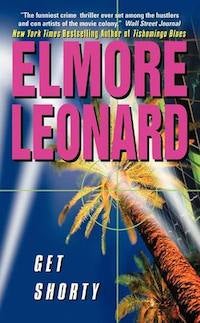
Get Shorty (1990)
This works as both easygoing entertainment and as Hollywood satire: It’s one of his best crime novels, and it’s got to be one of the 10 greatest Hollywood novels, period. Get Shorty was, in part, related to Leonard’s experience with Dustin Hoffman, who was hot to make LaBrava in the mid-’80s, only to drop out after much deliberation. Legendary deliberation. The “Shorty” in this book is a classic portrait of the finicky, self-absorbed movie star. Oh, and he’s short.
When the book came out, Hoffman called Leonard and asked if “Shorty” was supposed to be him. Leonard said, “Come on Dustin, you think you’re the only short actor in Hollywood?”

Maximum Bob (1991)
A personal favorite. This was published when Leonard was 65, well into his Jedi Master phase. You can practically see him smiling at the typewriter as you turn page after page. It’s maybe his funniest book, too. There are a lot of characters and subplots—it’s an ensemble piece, like an Altman movie—but Leonard never breaks stride. It’s a smooth, diamond-in-the-back, sunroof-top ride.
As Clifford Irving wrote in the L.A. Times:
Dark it is, because Leonard, like any true comic, has a melancholy view of the world and its primitive denizens. Without moralizing, he is telling us—no, he is showing us—how rotten life is in the heartland of the USA. In “Maximum Bob,” more than ever, he is the great delineator of the macho redneck, the professional thug, the semi-mindless street-wise slob who kills and maims and rapes because it’s part of the American mystique of violence and seems like fun, who periodically finds a home in prison so that he’s doing life-on-the-installment-plan, and is at the heart of the “crime problem” the rest of us discuss endlessly in the op-ed pages and at cocktail parties. But Leonard knows things the rest of us don’t, or at least he conjures them with such stunning imagination and sufficient editorial sense to create the aura of authenticity.
Also, Judge Bob Gibbs is one of Leonard’s finest comic creations.
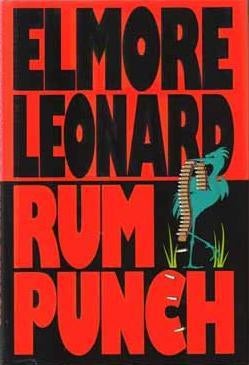
Rum Punch (1992)
“Sunday morning, Ordell took Louis to watch the white-power demonstration in downtown Palm Beach.” So begins a novel many know better for its film treatment, 1997’s Jackie Brown. Although Quentin Tarantino changed the title—and the lead role from a white to a black woman—Leonard loved the movie, and you can see why. Tarantino got the sensibility right, or at least came as close as you can get onscreen: understated, casual, and funny, with more than a trace of menace. In a 1998 interview with a longtime Dutch admirer, Leonard said:
I’m not concerned with how closely [one of my books] is adapted. I just hope it’s a good movie. For example, Rum Punch to Jackie Brown. Quentin Tarantino, just before he started to shoot, said, “I’ve been afraid to call you for the last year.” I said, “Why? Because you changed the title of my book? And you’re casting a black woman in the lead?” And he said, “Yeah.” And I said, “You’re a filmmaker. You can do whatever you want.” I said, “I think Pam Grier is a terrific idea. Go ahead.” I was very pleased with the results, too.
